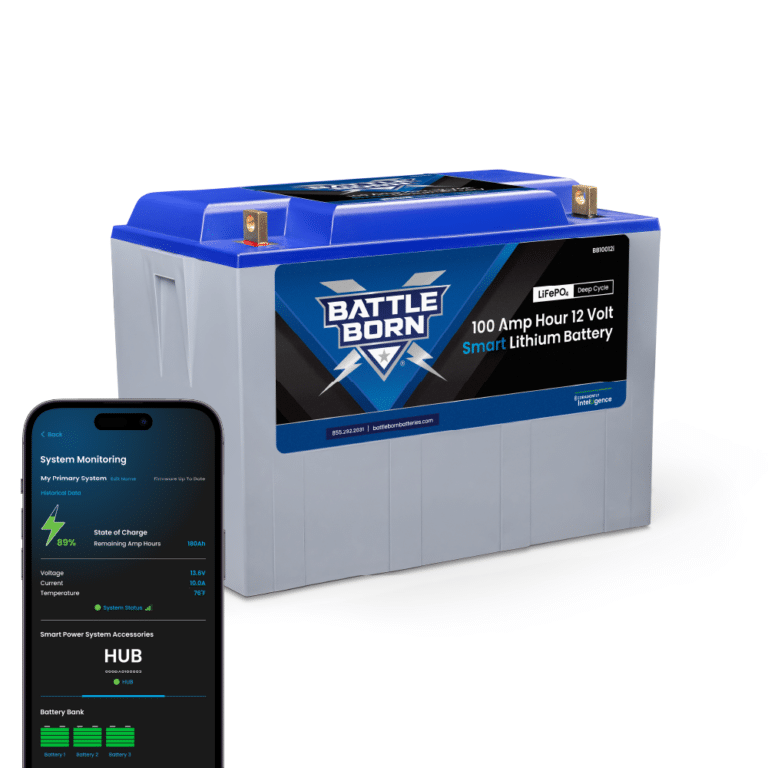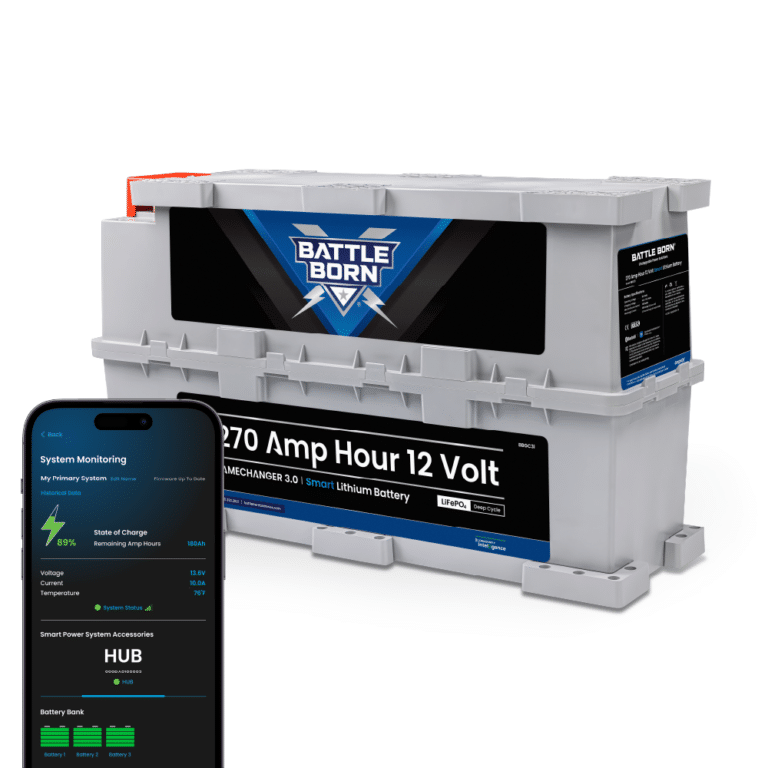
MENUMENU
TALK TO AN EXPERT
Special Hours: 7AM – 6PM PST
TALK TO AN EXPERT
Special Hours: 7AM – 6PM PST
In 1859, French physician Gaston Planté changed the world when he invented the first rechargeable lead acid battery. More efficient versions of his original design remain in use to this day—mostly in cars and large-scale industrial applications. But despite remaining very effective, lead acid batteries come with a wide range of health and environmental hazards.

We all know how dangerous lead is to our health. Exposure, especially in children, can lower IQ levels and hinder brain development. According to Duke University, exposure to leaded gasoline alone stole over 800 million cumulative IQ points between the 1940s and 1996, when it was officially banned.
Although we can thank Planté and his lead battery for where we are today, it’s time to leave this technology in the past if we’re serious about protecting our future. Let’s explore why lead-acid batteries are unsustainable and why we must look to alternative energy storage solutions to power our homes, RVs, and marine vehicles.

Batteries are fantastic, but make no mistake, the lead inside can be harmful to your health and the environment. While minimal exposure could lead to minor health concerns, more significant levels of exposure may have severe consequences. Furthermore, the mining and production of lead acid batteries is a contributory factor in soil and water pollution, greenhouse gas (GHG) emissions, and habitat destruction.
Lead acid batteries are primarily made of two highly toxic components: lead and sulfuric acid. As you likely remember from school, sulfuric acid is hazardous—even when diluted with water for battery use.
Fumes from these batteries contain traces of lead, among other harsh chemicals. Breathing them in will cause short-term discomfort. In the long term, however, you’ll be more at risk of tooth decay, certain types of cancers, and even cognitive decline.
In addition, battery acid can cause severe burns and result in permanent skin damage. Even worse, getting battery acid in your eyes may lead to blindness. Clean any exposed skin ASAP. The damage will continue as long as the acid is present.
Lead-acid batteries do considerable harm to the environment at every stage of their production cycle. Procuring the raw materials requires extensive mining—often in underdeveloped nations. And, even though lead acid batteries are 99% recyclable, individuals involved in their manufacture and reuse are often exposed to dangerous amounts of lead and sulfuric acid. Of course, recycling is still a net positive, as even a single lead battery can contaminate the groundwater over a wide area.
In batteries, energy density is measured by the amount of energy the battery contains in comparison with its size or weight. This is calculated by dividing a battery’s watt-hours by its weight (kg) or volume (liters). As such, the length of time a battery can power a device, compared with its size, gives us energy density.
Low energy density means bigger, heavier batteries with less power. High energy density means small, lighter batteries with more power. This is crucial because the higher the energy density, the longer that battery can emit a charge. Smartphones are the perfect example: tiny batteries that run all day—and more—before needing a charge.
Lead acid batteries have substantially lower energy densities than lithium-ion (Li-ion) and other non-lead batteries. They require more weight and volume to put out the same amount of energy. There’s a reason car batteries are so heavy.
Regarding electric vehicles (EVs) and motorhomes, battery size and weight become important factors. Most users prefer lightweight batteries that take up minimal space. Lead-acid batteries are heavy because they contain sizable amounts of naturally dense lead.
The average 3 KWh lead acid battery weighs around 66 pounds. It also has the lowest energy density among available battery options.
On the other hand, Li-ion batteries are much lighter (approximately 55% lighter than lead). A 3 KWh Li-ion battery weighs about 13 pounds. They also have greater energy density and don’t require the same amount of space.

Lead acid batteries have incredibly short life cycles. Even worse, more than 50% of them won’t last longer than half their expected lifespan. The result is the more frequent replacement, leading to further problems related to waste management. Even though lead batteries are recyclable, the process is far from straightforward.
In fact, lead acid batteries are presently one of the most recycled items on the planet. That said, 5% of these batteries still end up in landfills or junkyards, which translates to millions of metric tons of lead being dumped into the environment.
Li-ion batteries, on the other hand, have a much longer lifespan. For example, if you routinely discharge a lead acid battery down to 50%, it’ll give you between 500 and 800 cycles (or recharges) before it dies. Meanwhile, Li-ion batteries discharged down to 20% will give you 5,000 cycles before they need replacing.
As we’ve mentioned, Li-ion batteries are vastly superior to lead acid. First off, they have a considerably higher energy density. For ships, the average Li-ion battery has an energy density of 125–600+ Wh/L. Compare that with lead-acid’s 50–90 Wh/L and you’re looking at a battery that lasts up to 10x longer.
Li-ion batteries also charge significantly faster than their lead acid counterparts. They’ll provide between 85% and 100% of their total energy before requiring a recharge, whereas lead acid batteries peter out after 50%.
These are similar to traditional Li-ion batteries, but differ in how energy passes from their positive to negative ends. For instance, traditional Li-ion batteries use a liquid electrolyte, whereas solid-state batteries use one that’s solid.
Compared with traditional Li-ion, solid-state batteries provide a higher energy density, have even longer lifespans, and are more compact in size. Moreover, modern variants can attain an energy density that’s two and a half times greater than current Li-ion batteries—and exponentially more than lead-acid!
Solid-state is also safer. The liquid inside a Li-ion battery is extremely volatile and flammable. By contrast, the material in a solid-state battery won’t catch fire, even as it heats up.
Flow batteries have spent several decades in the R&D space. Today, they’re gaining traction as a better fit for large-scale grid storage systems, mainly due to their long life-time and impressive storage capacity.
Wind and solar renewables are intermittent, hence the need for storage during periods of excess production. Then, when production falls (for instance, when the wind isn’t blowing), this stored capacity supplies electrical energy for the grid. Here, flow batteries are considered the technology of choice.
Flow batteries may also lower the demand for lithium as more EVs come onto the road. We can use flow batteries for grid storage and save the lithium for cars and electric trucks.
Lead acid batteries have served their purpose, getting us to where we are today. That said, it’s time to move forward. Emerging technologies—now seen in Li-ion, solid-state, and flow batteries—are paving the way for a safer and more sustainable future.

Battle Born Batteries leads that charge with our industry-defining line of Li-ion batteries for RVs, vans, boats, and off-grid solar setups. Battle Born Batteries can give you two to three times the power in the same physical space and with just one-fifth of the weight. Moreover, they provide five times faster charging and a 100% depth of discharge.
Get in touch with Battle Born Batteries today to make the seamless transition from lead-acid batteries to more efficient Li-ion.
Shop Best Sellers








Ask a technical specialist now at 855.292.2831
Stay in the Know